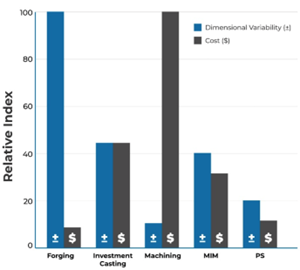A: The inherent positioning of metal injection molding is to manufacture large and complex metal parts, and its mesh shape is suitable for your palm. MIM can be used for many common alloys as well as unique alloys developed for specific applications. For simple geometries, other manufacturing technologies such as press sintering, turning parts, and stamping can produce components more cost effectively. However, MIM is the most cost-effective choice when compared with mass processing of complex geometric shapes or applications requiring high mechanical properties. Due to the processing capacity of the injection molding machine, MIM is also very suitable for the production of micro components with a mass of less than 1 gram, which is also difficult to achieve with other manufacturing technologies.
A: When comparing manufacturing processes, target payback periods must be set for up front tools and qualification investments. MIM is a highly scalable manufacturing process that relies on a single upfront investment in tooling. Tools can produce millions of components with relative ease. Customers rely on the supplier's equipment infrastructure, including injection molding machines and sintering furnaces. Due to tooling investment and capital equipment cost, when the output is close to 5000-10000 pieces (depending on the size of parts), MIM provides the maximum value.
The main drivers of component cost are equipment cycle time, furnace utilization and secondary operation. The cost of raw material composition plays a more variable role in MIM processing, which also includes alloy selection, geometry and other specifications. With the increase of the number of components, the manufacturing industry has realized economies of scale.
A: A good MIM part always starts with the right alloy choice. MIM can produce a variety of common and exotic alloys in addition to non-ferrous metals such as zinc, aluminum and magnesium. MIM components are usually placed in the palm of your hand and weigh less than 100 grams, with an average of about 15 grams .The wall thickness of MIM parts is usually greater than.010“, with complex characteristics on multiple axes.
A: The lead time for MIM component qualification depends on the time required to build the tool and verify the component process. For components of average complexity built in a two-cavity tool, the lead time for qualified first component qualification is typically 10-14 weeks.
A: Metal injection molding is most suitable for mass production. However, BRM needs to solve the increasingly serious problems in the market. Because of the important and long lead times associated with MIM tool qualification, engineers need a fast, low-cost choice to get real MIM parts. Prototype MIM was developed to solve this problem. It is a low-cost quick tool option to produce MIM components that are representative of actual production within 4-6 weeks. This allows engineers to test their designs and iterate before building production tools.
A: "MIM" parts can be printed by using the adhesive jet 3D printing technology, without investment in molds. This rapid prototyping option allows the production of small batches of metal parts with mechanical properties close to those of production MIM parts. This process uses the same sintering furnace and profiles, so BRM engineers can use this technology to test the configuration during qualification.
A: MIM is very close to the physical properties of forged products. Depending on the alloy and the size of the raw material powder, MIM can achieve densities of 96% to 97%. If desired, densities can be increased to 99% using secondary operations such as hot isostatic pressing. In most applications, MIM properties are virtually indistinguishable in terms of mechanical properties from parts derived from other manufacturing processes.
A: The selection of raw materials is crucial in the development of MIM manufacturing process. Most MIM manufacturers lack the technical ability to develop and manufacture their own raw materials, so they need to use commercial off the shelf power. However, this strategy does not allow users to fully control their processes. In APP, our high quality comes from our metallurgical expertise and the ability to produce raw materials internally. This provides us with the final control of raw materials and MIM processing, and reduces the supply chain risk of customers.
A: The goal of MIM is to produce producible parts in a net shape. In general, the MIM process includes a design average shrinkage of about 20% from the molded state to the sintered state. Even with shrinkage, MIM is a highly repeatable process. According to experience, if the specification tolerance is within+/-. 2% - of the dimension Within 5%, MIM is feasible. However, since MIM essentially focuses on complex geometries in applications requiring high accuracy, post sintering operations must be performed to dial in key functional dimensions. The following table describes how MIM is integrated with other manufacturing technologies.

A: After sintering MIM parts, secondary operations can be carried out to supplement or increase main functional dimensions, increase mechanical properties and improve surface appearance. These operations may include heat treatment, removal, die casting, machining, and hot isostatic pressing (HIP).
Contact: Cindy Wang
Phone: +86 19916725892
Tel: 0512-55128901
Email: [email protected]
Add: No.6 Huxiang Road, Kunshan development Zone, JiangsuShanghai Branch: No. 398 Guiyang Rd, Yangpu District, Shanghai, China